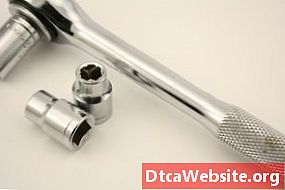
Contenu

A rusted fuel tank can pose a considerable problem for any vintage motorcycle enthusiast, especially as replacement tanks are becoming increasingly difficult to obtain. To combat this, many enthusiasts use a method called electrolysis to introduce an electrical current into a solution that fills the tank. The current displaces the rust from the tanks interior, which is then attracted to a piece of sacrificial steel anode. The entire process is fairly straightforward, but does require some preparation to ensure the best results. Expect the entire project to take a minimum of 48 hours to complete.
Preparation
Step 1
Remove the fuel tank from the motorcycle and drain out any remaining fuel. Remove the fuel valve from the tank, either by unscrewing it directly from the tank or by removing its mounting screws with a screwdriver. Flush the tank out with fresh water to remove any traces of fuel.
Step 2
Seal the portion of the tank that connects to the fuel valve. If your tank uses a bolt-on valve, then use a strip of rubber as a gasket then screw a piece of aluminum over the mounting point. Use a threaded rubber or plastic cap to seal a screw-on valves spigot.
Step 3
Create a sacrificial anode using either a length of steel rod or a wire coat hanger. Bend the wire or rod into an L-shape that will extend into the fuel tank. Select a rubber plug that will fit into the fuel tanks filler neck to act as an insulator to separate the anode from the fuel tank. Cut a small hole into the plug using a sharp knife. Push the anode through it until it extends at least three inches above the plug.
Step 4
Place the sacrificial anode and its rubber plug into the fuel tanks filler neck. Move the anode around to ensure that it does not come into contact with the sides of the fuel tank. Remove the anode and plug and make any adjustments as needed.
Prepare the electrolytic solution that will fill your fuel tank, using 100 percent sodium carbonate washing soda and water. Mix one tablespoon of washing soda for every gallon of water needed in a separate container. Make enough solution to fill your tank completely.
Rust Removal
Step 1
Fill the fuel tank with your electrolytic solution.
Step 2
Insert the sacrificial anode into the fuel tank until the rubber cap is seated lightly against the tanks filler neck. Move the anode around slightly to ensure that it does not touch the sides of the fuel tank.
Step 3
Connect a 12-volt automotive battery charger to the sacrificial anode and the fuel tank. Clip the battery chargers positive alligator connector to the extended portion of the anode, then clip the chargers negative alligator clip onto a section of the fuel tank.
Step 4
Turn the battery charger on to begin the electrolysis process. Allow the process to continue for a minimum of 24 hours, then turn the battery charger off. Withdraw the sacrificial anode and remove and rust deposits with a steel brush. Reinsert the anode and continue electrolysis for another 24 hours. Repeat as needed until rust deposits do not form on the anode.
Step 5
Turn the battery charger off and disconnect its alligator clips from the fuel tank and the anode. Drain the electrolytic solution from the fuel tank, then rinse the tank thoroughly with fresh water. Rinse the tank again, using acetone to remove any moisture from the fuel tanks interior.
Remove the seal from the fuel tank and reinstall the fuel valve, following the reverse method of removal. Reinstall the fuel tank onto the motorcycle and fill it immediately with fresh gasoline to prevent surface rust from forming within the tank.
Items you will need
- Screwdriver
- Water
- Threaded rubber or plastic cap
- Aluminum
- Rubber strip
- Steel rod or wire coat hanger
- Rubber plug
- Knife
- Sodium carbonate washing soda
- Container
- 12-Volt automotive battery charger
- Acetone
- Gasoline


